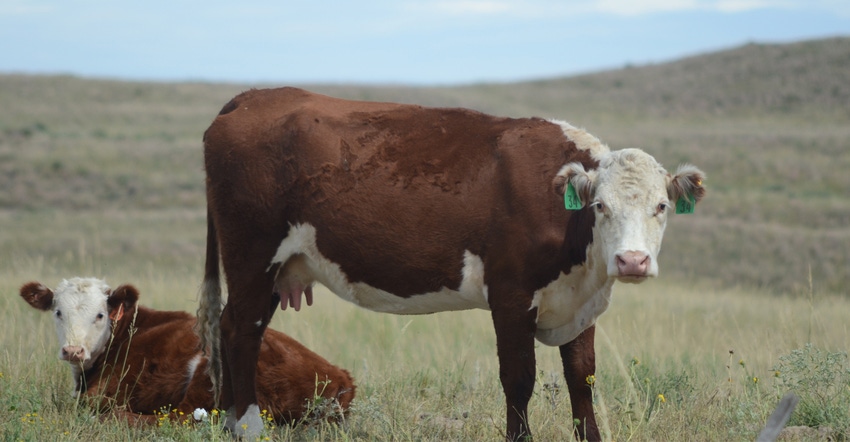June 16, 2020

Food production is essential, and that requires beef producers to carefully consider how COVID-19 infections may affect cattle work. It is important to remember how the virus is transmitted:
COVID-19 is spread mainly between people in close contact (6 feet or less).
The virus is believed to be spread through contact with droplets made when an infected person (who may not be showing symptoms) coughs, sneezes or talks. The virus may live airborne for a period.
It may be possible a person can get COVID-19 by touching a surface or object that has the virus on it, and then touching their own mouth, nose or possibly their eyes.
Related: Complete coronavirus coverage
Minimize the risk of becoming infected while also preventing the spread of the virus to others. Using this information, transmission risk can be reduced while working cattle.
Plan ahead
Reduce the number of people helping to work cattle. Ask high-risk individuals to stay at home.
Set up multiple washing sanitization stations and encourage frequent hand-washing.
Set up processing or work groups that are social contemporaries (already spending time together) and distance each group from each other. Do not allow the mixing of groups.
Draw a plan of the work area. Ask yourself is it safe? Will the work flow efficiently?
Communicate that plan to your workers beforehand about the way the activity will be conducted. Ask them to point out unintended flaws before the event.
Remind workers to use personnel protective equipment. This will vary with the task they are performing and includes long-sleeved shirts, leather gloves, face masks, plastic exam gloves, etc.
Work smaller groups per day per ranch or feedlot, which allows you to use less help.
Limit the number of cattle processing group activities each person attends per week or during a two-week period.
Day of the cattle work
If anyone is not feeling well, develops any sort of cough or has an elevated temperature, stay home for the health of the community.
Keep a list of who helps, so they can be contacted if anyone becomes sick.
Limit social interaction following or preceding the cattle work.
Assign someone to act as a biosecurity lead, reminding workers about physical distance, hand-washing, etc. Recognize that habit is powerful, and it is difficult to institute these new protocols without reminders. Remember we are all in this together.
Have extra gloves and masks available at the site.
If a meal is served, have servers wear gloves, eat outside and keep your distance. However, packing your own lunch is the safest and simplest way to eat when working cattle.
Communicate with people coming to your ranch or farm
When consultants, veterinarians, dealers, mechanics, etc., visit your operation, set up appointments to include time, meeting place and your transmission control plan (physical distancing, cleaning and disinfection, personal protective equipment, etc.):
Confirm individuals are feeling well and have not traveled to high-risk locations before coming to your place.
Develop noncontact delivery methods by using drop-off locations.
Wash hands after handling packages and consider wearing gloves.
Consider disinfecting nonporous packaging.
Develop actual physical distancing reminders (tape on floor, barriers, etc.) for deliveries that require person-to-person interaction.
Wash or sanitize your hands before and after interaction.
Develop contingency plans in case essential supplies (feed, medicine, supplements, pesticides, others) become unavailable. Be aware of your current inventory of essential supplies.
Clean vehicles, tractors, implements and tools
Place hand sanitizer or disinfectant wipes in equipment and other shared areas (shop, calving barn, etc.). When changing operators or users, consider doing the following before and after each use:
Disinfect hands with sanitizer and all high-touch areas (e.g. steering wheel, control handles, door handles, syringes, etc.)
Consider disposable covers for porous surfaces such as seats and other upholstered surfaces.
Allow three hours for virus to die in confined spaces (e.g. cabs), if possible.
For more information specific to vehicles, see cdc.gov.
Follow BQA guidelines when working cattle
Read and follow the label for all products used.
Extra-label drug use shall be used only when prescribed by a veterinarian, working under a valid veterinary-client-patient-relationship.
Adhere to withdrawal periods.
Record individual and group treatments by including the following information: group (e.g. Yearling replacement heifers) or individual animal (e.g. tag # 9123) identification; date treated; product administrated and manufacturer’s lot or serial number; dosage used; route, location and person administering the product; and latest date animal will have cleared withdrawal period.
If following these guidelines, you should reduce spread of the virus while maintaining your BQA certification.
More information
Saner and Meyer are Nebraska Extension educators.
Source: UNL BeefWatch, which is solely responsible for the information provided and is wholly owned by the source. Informa Business Media and all its subsidiaries are not responsible for any of the content contained in this information asset.
Read more about:
Covid 19You May Also Like




